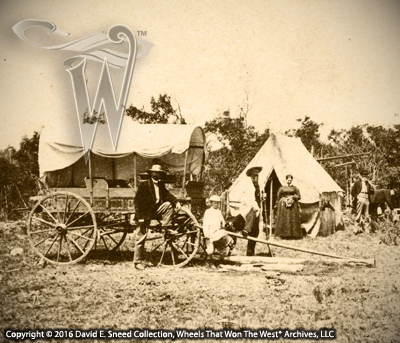I count it a privilege each week to share with an ever-widening group of folks interested in America’s first transportation industry. As part of that stewardship, we appreciate your weekly visits and regularly work to highlight abroad range of wood-wheeled history. This week, I’m focused on some mistakes occasionally inflicted on this subject; innocent-seeming blunders that can go the extra mile to harm the preservation of history.
Case in point... For decades, I’ve watched America’s modern television documentaries and dramas delve into areas requiringthe appearance of wood-wheeled wagons. This past week, I saw it again; not one but two, recently-produced network programs touting the significance of early American history – yet using wagons vastly inappropriatefor the time period shown. This might seem like a trivial mistake but these types of oversights and indiscretions have helped to continually build a perception that early wooden wagons are overly simplistic, irrelevant, and generic creations.
The problem with such a universal,one-size-fits-all approach is not only that we lose touch with the innovativegenius and design standards that paved the way for other accomplishments but wealso lose contact with entire segments of America’s movement west. I’ll talk more about that in just a bit. In the meantime, suffice it to say thatinaccurate representations of transportation history are a destructive disserviceleaving many of our nation’s most relevant wheels – and stories – snubbed andforgotten.
Any old wooden wagon used as a visual propfor a major communications event – i.e. authoritative documentary – will notsuffice any more than any old gun, saddle, train, town, pair of boots, or setof clothes is appropriate. Thesevehicles were individuals that could vary greatly depending on the era, brand,user, and segment of the country.
 | |
|
There are easily dozens – perhaps evenhundreds of obvious differences (depending on the era) – between a wagon usedin one timeframe/region of the U.S. compared to another. Certain design features and technologiesweren’t even used until a particular point in time. In other words, every part of these vehicleshad a beginning. So, if a televisionprogram is showing an American wagon being used in the 1700’s, there’s noexcuse for including a running gear with cast skeins. Even if the timeframe being covered is thevery late 1700’s, we’re still decades ahead of the first use of castskein technology. From the way thevehicles were painted to the individual features and overall designs shown onthe box, running gear, and accessories, the differences are real. Because of that, it’s increasingly evidentwhen shortcuts are taken and the homework hasn’t been done for a particular program.
Okay... Back to the loss of Americanhistory that I alluded to in the second paragraph above. Can anyone show me one of the purported200,000 wagons that legendary St. Louis wagon maker Joseph Murphy made? How about one of the hundreds of giant, Jacksonfreight wagons used in the West? Howmany Studebaker Roundup wagons have been forgotten and left to rot – perhaps allof them? How many original, high wheel, drop tongueOwensboro brand wagons have you seen? Yep, they built a lot of them – and they were of a different design thanmost are familiar with today. Would yourecognize a legendary Espenshied brand wagon if you saw it? Why is all of this important? Beyond the responsibility to show yesterdayas it truly was is the need to respect and save our wheeled past for what it is. Much of the Old West was dominated by majorvehicle brands. Even though these wheels were extremely popular most of them are virtually impossible to find now. In fact, every day, the last vestiges of the legendary brands that carried our 19thcentury heritage are withering away. Why? Because, it’s impossible toactively save valuable history if we don’t recognize and share that significancewhen we see it. Then again, it’s hard to‘see’ something if it's continually promoted as a rudimentary, inconsequentialprop.
Reinforcing that point, if all segmentsof history are equal, then why don’t we just save one early computer and alloweverything else to fade away? That way, 200years from now, everyone will know exactly what a computer looked and worked like – noneed to confuse anyone with details, right? Okay, you can see the ludicrous nature of that example. I realize that I’m mostly preaching to thechoir. Hopefully, though, there might eventuallybe a television or motion picture producer that stumbles across this blog andcomes to the realization that an entire, massive industry has been largelymisrepresented for the better part of the last century.
Kuddos to so many of you alreadypromoting accurate western vehicle history and perceptions. You’re doing a valued service for current andfuture generations. I see that kind ofauthenticity in a lot of places and it’s a tremendous benefit to folks all overthe country. So, keep up the good workand send us an email showing your involvement in cookouts, competitions, schoolfunctions, shows, benefits, and the like. We’denjoy the opportunity to share your passion and respect for America’s wheeledhistory within this blog as well.
Take care and have a good week.
Please Note: As with each of our blog writings, all imagery and text is copyrighted with All Rights Reserved. The material may not be broadcast, published, rewritten, or redistributed without prior written permission from David E. Sneed, Wheels That Won The West® Archives, LLC
Please Note: As with each of our blog writings, all imagery and text is copyrighted with All Rights Reserved. The material may not be broadcast, published, rewritten, or redistributed without prior written permission from David E. Sneed, Wheels That Won The West® Archives, LLC